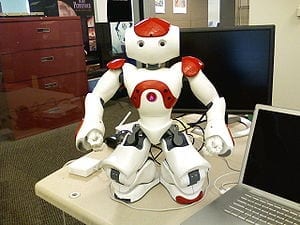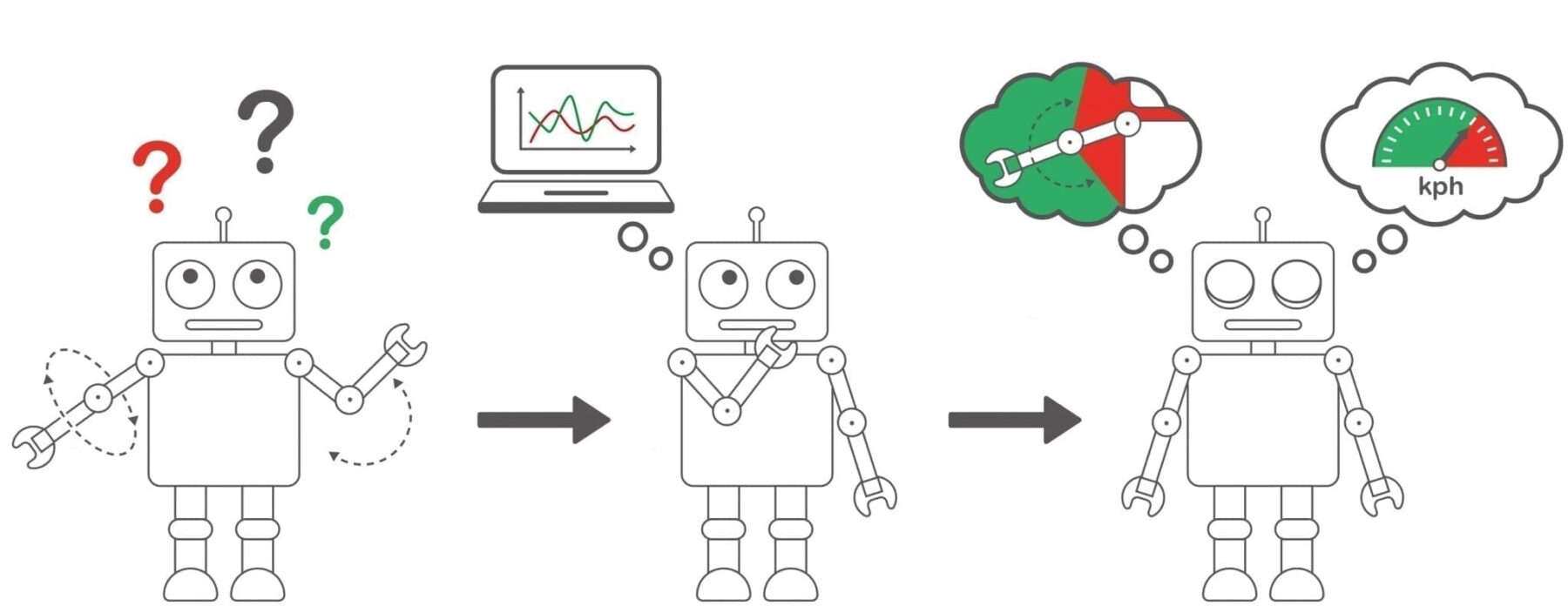
More and more, they are also beginning to imitate — and look like — humans. And they are beginning to perform tasks as humans do, too.
On a recent morning Natanel Dukan walked into the Paris offices of the French robot maker Aldebaran and noticed one of the company’s humanoid NAO robots sitting on a chair. Mr. Dukan, an electrical engineer, could not resist. Bending over, he kissed the robot on the cheek. In response the NAO tilted its head, touched his cheek and let out an audible smack.
It is certainly a very French application for a robot, but the intimate gesture by the $16,000, two-foot robot, now being used in academic research labs and robotic soccer leagues, also reflects a significant shift.
Until recently, most robots were carefully separated from humans. They have largely been used in factories to perform repetitive tasks that required speed, precision and force. That generation of robots is dangerous, and they have been caged and fenced for the protection of workers.
But the industrial era of robotics is over. And robots are beginning to move around in the world.
More and more, they are also beginning to imitate — and look like — humans. And they are beginning to perform tasks as humans do, too.
Many of the new generation of robots are tele-operated from a distance, but are increasingly doing tasks independent of direct human control.
For instance, Romeo, a five-foot humanoid robot, will soon be introduced by Aldebaran as a “big brother” to the pipsqueak, kissing NAO robot. Created with the assistance of $13.8 million from the French government, the costly robot is being programmed to care for older people and assist in the home.
To provide useful assistance, it will have to do more than the repetitive work already being performed by commercial robots in factories, hospitals and other settings. Moreover, the new robots are designed not just to replace but to collaborate with humans.
The idea that robots will be partners of humans, rather than stand-ins or servants, is now driving research at universities and industrial laboratories. This year, new United States industry standards for robotic manufacturing systems were published, underscoring the emergence of the field. The standards specify performance requirements that will permit human workers to collaborate with robots directly, and they reverse manufacturing guidelines from 1999 that prohibited “continuous attended operations” requiring humans to be in close contact with robots that were deemed unsafe by the industry.
Go deeper with Bing News on:
Robots More Like Us
- Watch terrifying ‘terminator’ robot dog with AI-targeting rifles being tested by US Marines
THE US Marines ... AI and robots. "Make sure the robot is working for the human and the human is not working for the robot," Denomy said. The colonel gave an example of a recent robot test, which left ...
- Robot Operating System Market: Projected Surge to US$ 490.3 Million by 2033, Propelled by a 5.7% CAGR
The worldwide robot operating systems market was worth approximately US$ 249.2 million in 2021. Over the next decade, it is expected to grow at an average annual rate of 5.7%. By 2033, it is ...
- Can robots help keep us safe?
Robots are becoming increasingly more common across multiple industries ... One machine introduced last December is designed to disinfect places like hotels and restaurants with UV light, moving ...
- Tom Brady's roast made him seem like a real person for once, not just a football robot
This is For The Win’s daily newsletter, The Morning Win. Did a friend recommend or forward this to you? If so, subscribe here. Have feedback? Leav ...
- Tesla's Optimus video flub has other robot makers assuring us their robots are legit
Elon Musk became the butt of more than a few jokes after internet users pointed out Tesla’s robot demo wasn’t all it appeared to be. As it turns out, a video the billionaire posted of Optimus, the ...
Go deeper with Google Headlines on:
Robots More Like Us
[google_news title=”” keyword=”Robots More Like Us” num_posts=”5″ blurb_length=”0″ show_thumb=”left”]
Go deeper with Bing News on:
Independent robots
- US Marines Special Operations Evaluate Armed Robot Dogs for Military Use
Discover how MARSOC is testing armed robotic dogs for military use, raising ethical questions about autonomy and human oversight in warfare.
- Get an iRobot Braava Jet m6 robot mop for $299 with this limited-time deal
The Braava Jet m6 is iRobot's tried-and-true robot mop. Popular for its effective mopping and reliability, buyers can take advantage of a limited-time deal and get it for 34% off.
- Exclusive: Wayve co-founder Alex Kendall on the autonomous future for cars and robots
U.K.-based autonomous vehicle startup Wayve started life as a software platform loaded into a tiny electric "car" called Renault Twizy. Festooned with ...
- AI robots figure out how to play football in shambolic footage
Robots fitted with AI developed by Google’s DeepMind have ... From news to politics, travel to sport, culture to climate – The Independent has a host of free newsletters to suit your interests. To ...
- China may have sent secret robot to Moon’s far side in Chang’e 6 launch
The mission’s main payload is expected to touch down in a crater near the Moon’s south pole in early June, where a lander would scoop up 2kg of rocks and send them back to Earth in a return module.
Go deeper with Google Headlines on:
Independent robots
[google_news title=”” keyword=”independent robots” num_posts=”5″ blurb_length=”0″ show_thumb=”left”]










